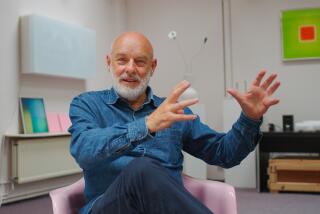‘Tim’s Vermeer’ takes an engineer’s approach to painting
The subject of the documentary “Tim’s Vermeer” isn’t Johannes Vermeer, the 17th century Dutch artist renowned for his luminescent paintings. The true protagonist of the movie is Tim -- Tim Jenison, that is -- an unassuming computer engineer from Texas who embarks on a journey to upend the way we think about Vermeer and his masterpieces.
Jenison believes the Dutch artist used a clever contraption of mirrors to aid in the creation of his paintings. Jenison’s attempt to replicate Vermeer’s “The Music Lesson” using such a device forms the backbone of the documentary, which opened in December for an awards-qualifying run and is back in cinemas starting Friday.
“We know he was trying to achieve realism. To me as a computer graphics guy, [Vermeer] was a kindred spirit,” Jenison said in a recent phone interview. “He was a scientist and an artist.”
CRITICS’ PICKS: What to watch, where to go, what to eat
Penn & Teller, the illusionists known for their stage acts, were producers on the film. Penn Jillette (the tall one) had known Jenison for years, and when he learned about Jenison’s project to replicate a Vermeer, he and Teller decided it would make an interesting movie. Teller directed the documentary.
At least initially, no one else was interested in producing it. Jenison recalled one producer leaving the room during a meeting. “She came back and said it was an interesting idea but said she didn’t think I could pull off the painting.”
Jenison created an artist studio in San Antonio modeled after the one Vermeer probably used to create “The Music Lesson.” Using his mirror device, he spent months working tediously on his version of the painting. (Without giving too much away, the device allows a user with minimal art experience to create a painting using a model or another work of art as a basis.)
The elaborate experiment was inspired in part by David Hockney’s book “Secret Knowledge,” which argued that some old masters used optics and devices such as the camera obscura to aid in the creation of their art. Hockney is an interview subject in “Tim’s Vermeer,” providing his own bemused assessment of Jenison’s mirror contraption.
ART: Can you guess the high price?
Teller said much of the footage in the movie was created by Jenison using a series of self-operated cameras.
“A documentary like this could never have been made 10 years ago. There was a lot of un-manned shooting,” Teller said. More than 2,000 hours of footage were whittled down in the editing room to just 80 minutes.
Jenison is the founder of NewTek, a Texas company specializing in video and graphics. He said the back-breaking work of replicating a Vermeer for the movie left him exhausted. But he said the experience whetted his appetite to tackle another old master.
“I suspect that Caravaggio knew this single mirror trick. He had a lot of mirrors in his possession, and he didn’t let any one watch him paint,” Jenison said.
“I’d like to satisfy my curiosity to paint something like Caravaggio -- but not for another film.”
ALSO:
Monuments Men gallery to open at National WWII Museum
Denver, Seattle museums put artworks on the line in Super Bowl wager
Review: Alfredo Ramos Martínez, champion of ordinary people, revisited
More to Read
The biggest entertainment stories
Get our big stories about Hollywood, film, television, music, arts, culture and more right in your inbox as soon as they publish.
You may occasionally receive promotional content from the Los Angeles Times.







